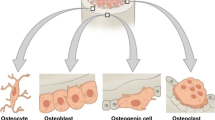Abstract
Hydroxyapatite (HA) coatings have been used to improve implant fixation by promoting bone formation around the prosthesis. A macrophage response to HA particulates has been noted around loosened HA-coated prostheses. As biomaterial wear particle-associated macrophages are known to be capable of differentiating into osteoclasts that are capable of bone resorption, we examined whether particulate HA could similarly induce macrophage-osteoclast differentiation. HA-associated macrophages were isolated from granulomas, formed by subcutaneous implantation of HA, and co-cultured with UMR 106 osteoblast-like cells in the presence of 1,25-dihydroxyvitamin D3 for up to 14 days on glass coverslips and bone slices. HA-associated macrophage-osteoclast differentiation was evidenced by the formation of numerous multinucleated tartrate resistant acid phosphatase (TRAP)-positive cells which formed lacunar resorption pits on bone slices. Polymethylmethacrylate (PMMA) particle-associated macrophages, isolated from subcutaneous PMMA-containing granulomas, caused significantly more osteoclast formation and bone resorption than HA-associated macrophages. These results indicate that macrophages responding to HA particles are capable of osteoclast differntiation. They also suggest that particles derived from uncemented (HA-coated) implants are likely to induce less osteoclast formation and osteolysis than cemented implants. © 2001 Kluwer Academic Publishers
Similar content being viewed by others
References
P. G. Bullough, E. F. Dicarlo, K. K. Hansraj and M. C. Neves, Orthop. Clin. North. Am. 19 (1988) 611.
D. W. Lennox, B. W. Schofield, D. F. Mcdonald and L. H. Riley, Clin. Orthop. 225 (1987) 171.
P. A. Revell, in “Current Trends in Pathology” (Springer-Verlag, Berlin, 1982) p. 137.
K. J. Kim, H. E. Rubash, S. C. Wilson, J. A. D'antonio and E. J. Mcclain, Clin. Orthop. 287 (1993) 142.
D. W. Murray and N. Rushton, J. Bone Joint Surg. 72B (1990) 988.
W. A. Jiranek, M. Machado, M. Jasty, D. Jervevar, H. J. Wolfe and S. R. Goldring, ibid 75A (1993) 863.
J. M. W. Quinn, C. Joyner, J. T. Triffitt and N. A. Athanasou, ibid 74B (1992) 652.
A. Sabokbar, Y. Fujikawa, S. D. Neale, D. W. Murray and N. A. Athanasou, Ann. Rheum. Dis. 56 (1997) 414.
A. Sabokbar, R. Pandey, J. M. W. Quinn and N. A. Athanasou, Arch. Orthop. Trauma. Surg. 184 (1998) 31.
N. A. Athanasou, J. Bone Joint Surg. 78A (1996) 1096.
W. L. Jaffe and D. F. Scott, ibid. 78A (1996) 1918.
K. SØballe, K. Gotfredsen, H. Brockstedt-rasmussen, P. T. Nielsen and K. Rechnagel, Clin. Orthop. 272 (1991) 255.
R. D. Bloebaum and J. A. Dupont, J. Arthroplasty 8 (1993) 195.
R. D. Bloebaum, D. Beeks, L. D. Dorr, C. G. Savory, L. A. Dupont and A. A. Hofmann, Clin. Orthop. 298 (1994) 19.
T. W. Bauer, S. K. Taylor, M. Jiang and S. V. Medendrop, ibid. 298 (1994) 11.
M. Nagase, D. G. Baker and R. Schumacher Jr, J. Rheumatol. 15 (1988) 1334.
Y. Harada, J. T. Wang, V. A. Doppalapudi, A. A. Willis, M. Jasty, W. H. Harris, M. Nagase and S. R. Goldring, J. Biomed. Mater. Res. 31 (1996) 19.
J. S. Sun, F. H. Lin, T. Y. Hung, Y. H. Tsuang, W. H. S. Chang and H. C. Liu, ibid. 45 (1999) 311.
R. Pandey, J. M. W. Quinn, C. Joyner, D. W. Murray, J. T. Triffitt and N. A. Athanasou, Ann. Rheum. Dis. 55 (1996) 388.
N. A. Athanasou, J. M. W. Quinn and C. J. Bulstrode, J. Bone Joint Surg. 74B (1992) 57.
C. Minkin, Calcif. Tissue Int. 34 (1982) 285.
J. M. Austyn and S. Gordon, Eur. J. Immunol. 11 (1981) 805.
D. L. Lacey, E. Timms, H. L. Tan, M. J. Kelley, C. R. Dunstan and T. Burgess, Cell 93 (1998) 165.
J. Glowacki and K. A. Cox, Calcif. Tissue Int. 39 (1986) 97.
S. C. Marks and T. J. Chambers, J. Bone Min. Res. 6 (1991) 395.
S. D. Neale, D. R. Haynes, D. W. Howie, D. W. Murray and N. A. Athanasou, J. Arthroplasty (2000) 15(5):654.
E. J. Evans and E. M. H. Clarke-Smith, Clin. Mater. 7 (1991) 241.
J. M. Quinn, A. Sabokbar, M. Denne, M. C. Devernejoul, J. O. D. Mcgee and N. A. Athanasou, Calcif. Tissue Int. 60 (1997) 63.
W. Wang, A. Sabokbar, A. H. R. W. Simpson and N. A. Athanasou, Hip Int. (1999) 9(4):178.
Author information
Authors and Affiliations
Corresponding author
Rights and permissions
About this article
Cite this article
Sabokbar, A., Pandey, R., Díaz, J. et al. Hydroxyapatite particles are capable of inducing osteoclast formation. Journal of Materials Science: Materials in Medicine 12, 659–664 (2001). https://doi.org/10.1023/A:1011267005465
Issue Date:
DOI: https://doi.org/10.1023/A:1011267005465




